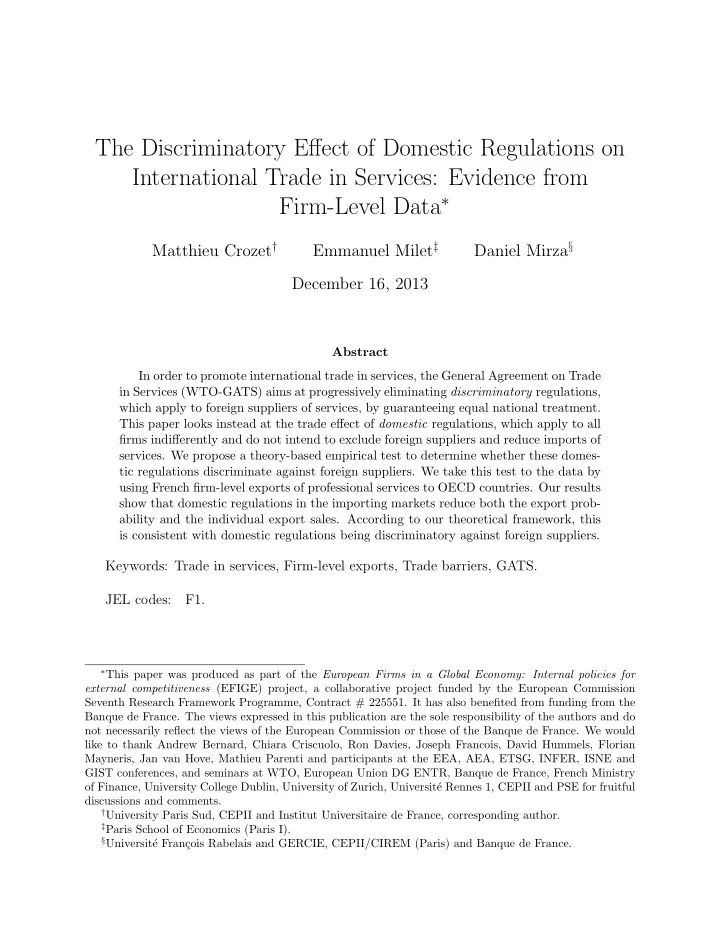

The Discriminatory Effect of Domestic Regulations on International Trade in Services: Evidence from Firm-Level Data ∗ Matthieu Crozet † Emmanuel Milet ‡ Daniel Mirza § December 16, 2013 Abstract In order to promote international trade in services, the General Agreement on Trade in Services (WTO-GATS) aims at progressively eliminating discriminatory regulations, which apply to foreign suppliers of services, by guaranteeing equal national treatment. This paper looks instead at the trade effect of domestic regulations, which apply to all firms indifferently and do not intend to exclude foreign suppliers and reduce imports of services. We propose a theory-based empirical test to determine whether these domes- tic regulations discriminate against foreign suppliers. We take this test to the data by using French firm-level exports of professional services to OECD countries. Our results show that domestic regulations in the importing markets reduce both the export prob- ability and the individual export sales. According to our theoretical framework, this is consistent with domestic regulations being discriminatory against foreign suppliers. Keywords: Trade in services, Firm-level exports, Trade barriers, GATS. JEL codes: F1. ∗ This paper was produced as part of the European Firms in a Global Economy: Internal policies for external competitiveness (EFIGE) project, a collaborative project funded by the European Commission Seventh Research Framework Programme, Contract # 225551. It has also benefited from funding from the Banque de France. The views expressed in this publication are the sole responsibility of the authors and do not necessarily reflect the views of the European Commission or those of the Banque de France. We would like to thank Andrew Bernard, Chiara Criscuolo, Ron Davies, Joseph Francois, David Hummels, Florian Mayneris, Jan van Hove, Mathieu Parenti and participants at the EEA, AEA, ETSG, INFER, ISNE and GIST conferences, and seminars at WTO, European Union DG ENTR, Banque de France, French Ministry of Finance, University College Dublin, University of Zurich, Universit´ e Rennes 1, CEPII and PSE for fruitful discussions and comments. † University Paris Sud, CEPII and Institut Universitaire de France, corresponding author. ‡ Paris School of Economics (Paris I). § Universit´ e Fran¸ cois Rabelais and GERCIE, CEPII/CIREM (Paris) and Banque de France.
1 Introduction Services account for about two thirds of the GDP and nearly half of the employment in advanced economies. The share of service activities in GDP has also risen in middle and low income countries, reaching about 50% in 2007 in developing economies (Francois and Hoekman, 2010). Nevertheless, international trade in services still accounts for only one fifth of world trade (WTO, 2008). Of course, many services require proximity between buyers and sellers which prevents most of them from being internationally traded. However, if one focuses on services that do not require proximity (i.e. arm’s length services), 1 international trade of services remains limited. Simple calculations from EBOPS-OECD and STAN-OECD databases for the US economy in 2008 show that the share of exports of services in the total production of arm’s length services is around four times smaller than the share of exported goods in total manufacturing. Why then is there so little trade in arm’s length services? Since usual trade restrictions such as tariffs do not apply to the international provision of services, market regulations are considered to be a major impediment. Market regulations can be discriminatory or not (Deardorff and Stern, 2003). Discriminatory regulations , that impose to foreign suppliers a different treatment to the one applied to local suppliers, are obvious instruments of trade protection. Non-discriminatory regulations, usually referred to as domestic regulations , apply to all suppliers alike, and are not considered as trade barriers. However, foreigners can be more sensitive to these regulations than their domestic counterparts as they do not have access as easily to information to avoid or comply with local legislations. Even if they are not deliberately discriminatory, domestic regulations are likely to exclude foreign suppliers. In this paper, we ask whether domestic regulations can be considered as trade barriers, combining data on domestic regulations in 28 OECD countries with data on French firm-level exports of professional services. The purpose of the General Agreement on Trade in Services (GATS) is to promote international trade in services by ensuring equal treatment between national and foreign suppliers. 2 Quite naturally, it mostly focuses on regulations that discriminate against foreign suppliers, thus granting a relative advantage to local suppliers. In Article VI, the GATS also deals with domestic regulations. This Article VI is quite elusive, however. It only states that domestic regulations should not “constitute unnecessary barriers to trade in services”. A precise assessment of the effect of domestic regulations on trade in services is needed to determine whether they should receive more attention during trade negotiations. The empirical literature has provided evidence in favor of a significant trade effect of regulations in the service sectors (see Francois and Hoekman, 2010, for a survey). Kox and Nord˚ as (2007); Lennon (2009) and van der Marel and Shepherd (2011) use aggregate data on bilateral trade in services from the OECD and show that regulations in the origin and destination countries have a strong negative impact on aggregate export of services. Kox and Lejour (2005) show that it is not only the level of regulations which matters for ex- ports but also their structure. Controlling for unobserved country heterogeneity, Schwellnus (2007) finds a smaller – but still significant – elasticity of bilateral trade with respect to 1 An expression that has been made popular by Bhagwati et al. (2004). 2 See the WTO website devoted to the GATS at http://www.wto.org/english/tratop_e/serv_e/serv_ e.htm 1
Recommend
More recommend